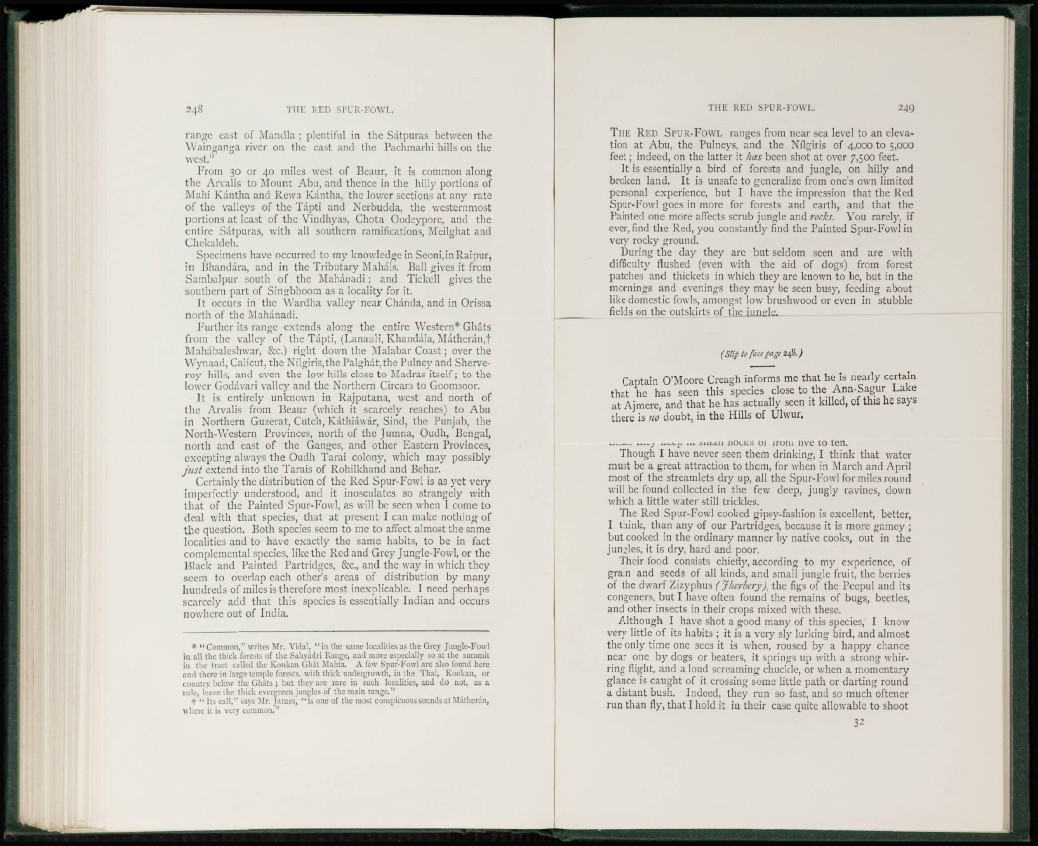
range cast of Manilla ; plentiful in the Satpuras between the
Wainganga river on the east and the Pachmarhi hills on the
west."
From 30 or 40 miles west of Eeaur, it is common along
the Arvalis to Mount Abu, and thence in the hilly portions of
Mahi Kantha and Rewa Kantha, the lower sections at any rate
of the valleys of the Tapti and Nerbudda, the westernmost
portions at least of the Vindhyas, Chota Oodeypore, and the
entire Satpuras, with all southern ramifications, Meilghat and
Chckaldeh.
Specimens have occurred to my knowledge in Seoni.inRaipur,
in Bhandara, and in the Tributary Mahals. Ball gives it from
Sambalpur south of the Mahanadi ; and Tickcll gives the
southern part of Singbhoom as a locality for it.
It occurs in the Wardha valley near Chanda, and in Orissa
north of the Mahanadi.
Further its range extends along the entire Western* Ghats
from the valley of the Tapti, (Lanauli, Khandala, Matheran,f
Mahabaleshwar, &c.) right down the Malabar Coast; over the
Wynaad, Calicut, the Ni'lgiris.thc Palghat, the Pulney and Sherveroy
hills, and even the low hills close to Madras itself; to the
lower Godavari valley and the Northern Circars to Goomsoor.
It is entirely unknown in Kajputana, west and north of
the Arvalis from Beaur (which it scarcely reaches) to Abu
in Northern Guzerat, Cutch, K&thiawdr, Sind, the Punjab, the
North-Western Provinces, north of the Jumna, Oudh, Bengal,
north and east of the Ganges, and other Eastern Provinces,
excepting always the Oudh Tarai colony, which may possibly
just extend into the Tarais of Rohilkhand and Behar.
Certainly the distribution of the Red Spur-Fowl is as yet very
imperfectly understood, and it inosculates so strangely with
that of the Painted Spur-Fowl, as will be seen when I come to
deal with that species, that at present I can make nothing of
the question. Both species seem to me to affect almost the same
localities and to have exactly the same habits, to be in fact
complcmcntal species, like the Red and Grey Jungle-Fowl, or the
Black and Painted Partridges, &c., and the way in which they
seem to overlap each other's areas of distribution by many
hundreds of miles is therefore most inexplicable. I need perhaps
scarcely add that this species is essentially Indian and occurs
nowhere out of India.
* " Common," writes Mr. Vidal, "in tire same localities as tire Grey Jungle-Fowl
in all the thick forests of the Sahyadri Range, and more especially so at the summit
in (lie tract called the Konkan Ghat Mahta. A few Spur-Fowl arc also found here
and there in large temple forests, with thick undergrowth, in the Thai, Konkan, or
country below tire Ghats ; but they are rare in such localities, and do not, as a
rule, leave the thick evergreen jungles of the main range."
t "Its call," says Mr. Tames, "is one of the most conspicuous sounds at Mathcran,
where it is. very common."
THE RED SPUR-FOWL ranges from near sea level to an elevation
at Abu, the Pulneys, and the Nflgiris of 4,000 to 5,000
feet; indeed, on the latter it has been shot at over 7,500 feet.
It is essentially a bird of forests and jungle, on hilly and
broken land. It is unsafe to generalize from one's own limited
personal experience, but I have the impression that the Red
Spur-Fowl goes in more for forests and earth, and that the
Painted one more affects scrub jungle and rocks. You rarely, if
ever, find the Red, you constantly find the Painted Spur-Fowl in
very rocky ground.
During the day they are but seldom seen and are with
difficulty flushed (even with the aid of dogs) from forest
patches and thickets in which they are known to be, but in the
mornings and evenings they may be seen busy, feeding about
like domestic fowls, amongst low brushwood or even in stubble
fields on the outskirts of the inno-le.
(Slip to face page 248. J
Captain O'Moore Creagh Informs me that he is nearly certain
that he has seen this species close to the Ana-Sagur Lake
at Ajmere, and that he has actually seen it killed, of this he says
there is no doubt, in the Hills of Ulwur.
, ... j u i d i i HOCKS 01 110111 nve to ten.
Though I have never seen them drinking, I think that water
must be a great attraction to them, for when in March and April
most of the streamlets dry up, all the Spur-Fowl for miles round
will be found collected in the few deep, jungly ravines, down
which a little water still trickles.
The Red Spur-Fowl cooked gipsy-fashion is excellent, better,
I think, than any of our Partridges, because it is more gamey ;
but cooked in the ordinary manner by native cooks, out in the
jungles, it is dry, hard and poor.
Their food consists chiefly, according to my experience, of
grain and seeds of all kinds, and small jungle fruit, the berries
of the dwarf Zizyphus (Jlterbery). the figs of the Peepul and its
congeners, but I have often found the remains of bugs, beetles,
and other insects in their crops mixed with these.
Although I have shot a good many of this species, I know
very little of its habits ; it is a very sly lurking bird, and almost
the only time one sees it is when, roused by a happy chance
near one by dogs or beaters, it springs up with a strong whirring
flight, and a loud screaming chuckle, or when a momentary
glance is caught of it crossing some little path or darting round
a distant bush. Indeed, they run so fast, and so much oftener
run than fly, that I hold it in their case quite allowable to shoot